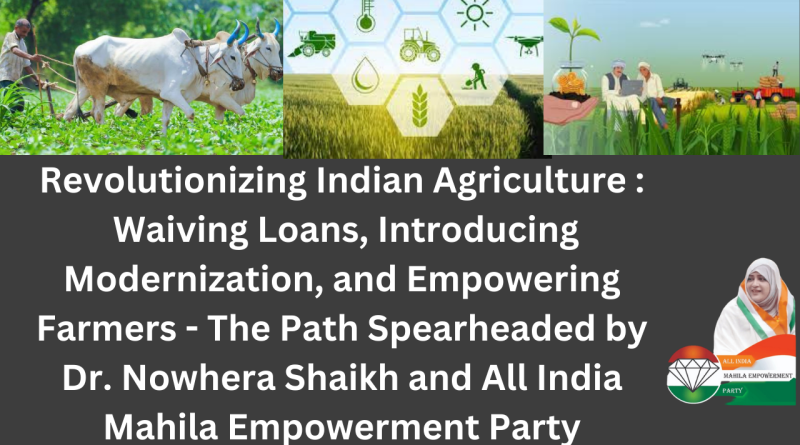Revolutionizing Indian Agriculture: Waiving Loans, Introducing Modernization, and Empowering Farmers – The Path Spearheaded by Dr. Nowhera Shaikh and All India Mahila Empowerment Party
I. Introduction
A. Understanding Rural India and Its Agricultural Condition
Let’s layout the map of rural India and its agricultural scene for you.
- Importance of Agriculture in India
Ah, agriculture! The backbone of the Indian economy, providing for nearly 60% of the population. It plays a central role in influencing food security, employment levels, and nutritional status. It even sways the growth rate of our means of making moolah, our GDP.
- Challenges Faced by Indian Farmers
Farmers in India have lived through a real “Game of Thrones” story, against a backdrop of erratic weather, pesky pests, and fickle market prices. With limited access to credit and technology, often they’re like Hercules, facing challenges that would make even the mighty Greek legend shudder.
- The Current state of Agricultural Loans
Now let’s talk about managerial economic problems with a pinch of M. Night Shyamalan-ish cliffhangers. Agricultural loans? A turbulent sea. High interest rates, meager loans, strict deadlines – sounds like an episode of “Money Heist”, right? Struggling farmers find themselves struck between the pervasive, crippling forces of debt and the harsh realities of agriculture.
B. The Role of the All India Mahila Empowerment Party (AIMEP)
Hang on, though. Enter Dr. Nowhera Shaikh. Enter AIMEP.
- Brief History and Mission of AIMEP
Stitched from the thread of emancipation and empowerment in 2014, AIMEP, led by Dr. Shaikh, has striven to boost the standard of living of marginalized sections, particularly women. They whack patriarchy on its head and dazzle empowerment like a medal.
- Dr. Nowhera Shaikh: The Founder and Her Vision
Dr. Nowhera Shaikh – Invincible and Invaluable. Picture a woman of wisdom, groundbreaking grit, and a genuinely grand vision. That’s her – a beacon of hope for struggling farmers and a prime-mover of agricultural transformation in India.
- The Connection between AIMEP, Dr. Nowhera Shaikh and Agriculture
But how does a political party tie up with agriculture? Bear with me. Both Dr. Shaikh and AIMEP work towards improving agricultural conditions, supporting farmers, and bringing about socio-economic Justice. Makes sense, right?
II. The Impact and Necessity of Agricultural Loan Waiver
A. The Ongoing Trend of Loan Waiver in India
Let’s talk credit, shall we?
- Recent Cases of Agricultural Loan Waiver
Over recent years, agricultural loan waivers in India have seen substantial action – like a Hollywood thriller. It’s pretty dramatic, with several states like UP, Maharashtra, and Punjab springing loan-waiver schemes.
- How Waiver Schemes Benefit Farmer
Don’t think of these loan waivers as Santa’s magical cookies: they’re not whimsical or instantaneous solutions, but more like a painkiller for a splitting headache. It’s a temporary respite for farmers pummeled by crippling debts.
- The Potential Drawbacks
But Rome wasn’t built in a day, and neither can farmer’s problems be solved with just waivers. Critics argue that it’s a one-size-fits-all approach, overlooking other plaguing issues like unequal land distribution, productivity, and technology access. It’s a tricky balancing act, folks!
B. AIMEP’s/Perspective on Agricultural Loan Waiver
Enter Dr. Shaikh, cutting through the clutter against this backdrop.
- Dr. Nowhera Shaikh’s Vision on Loan Waiver
She envisions waivers as a comprehensive strategy, one that combines relief with systemic reform. She’s all about empathy, sustainability, and helping farmers join the economic mainstream.
- AIMEP’s Actions and Future Plans for Loan Waiver
It’s not just all talk. AIMEP plans to propel agricultural policies and loan reforms to address farmers’ plights head-on. Think of them as Avengers assembling to safeguard the Indian agrarian universe!
- Anticipated Impacts of their Approach on Farmer Lives
This approach could bring about significant positive reforms in farmers’ lives. We’re looking at the light at the end of the tunnel, a break from crippling loans and an entry into a world of empowerment and self-sufficiency.
III. Technological Revolution in Farming: A Need of the Hour
A. Current State of Technology in Indian Agriculture
Alright, ready for a deep-dive into the world of tech innovations in Indian agriculture? Buckle up!
- Existing Farming Techniques followed in India
Indian farming techniques often seem to have taken a page from history textbooks. Rain-fed subsistence farming and age-old traditional practices continue to rule. To cut it short, we’re still playing “Snake” in a world of “PUBG.”
- Accessibility and Adoption of Modern Technology
The expanse of modern farming technology can seem like a tantalizing fruit hanging just out of reach to many Indian farmers. Tricky terrain here. A lack of awareness, funding, and training throw-up barricades in the path of adopting modern techniques.
- Case Studies of Successful Technological Adoption in Indian Agriculture
But hey, it’s not all gloomy. Acres of success stories dot the landscape. The success of KVK farm in Punjab employing drip irrigation or Anantapur farmers in Andhra Pradesh using sprinkler systems, show technology embracing agriculture in a warm hug.
B. The AIMEP and Dr. Nowhera Shaikh’s Approach to Farming Technology
See where we’re heading here?
- Their Commitment to Promote Technological Advances
Dr. Shaikh and AIMEP aim to connect farmers with technology like long-separated soulmates. They’re committed to empowering farmers with the latest tech-tools and aiming to transform India into an Agri-tech powerhouse.
- Strategies and Programs for Implementing Modern Technology
Their strategies involve the adoption of advanced farming techniques, collaboration with tech firms, funding for infrastructure, and extensive training programs. Funding, implementing, repeating – a tagline to their strategy!
- Long Term Impact of Modern Technology on Indian Agriculture
Imagine an agrarian landscape not relying on the monsoon’s whims but powered by precision farming, AI, and IoT – isn’t that an exciting future? The long-term impact of this approach could mark a new dawn of sustainable and profitable farming in India.
IV. Farmer Training Centers: Envisaging Self-Sufficient Villages
A. The Importance of Farmer Education and Training
Education – it’s not just about classrooms and textbooks.
- Overview of Current Farmer Knowledge and Skills
Here’s the thing. Many farmers rely on traditional wisdom passed down from their ancestors but could do with some extra support. A bit like Luke Skywalker – he was trained as a Jedi but was unstoppable when guided by Yoda.
- Scope and Necessity of Farmer Training Centers
In comes the concept of farmer training centers. Picture these as knowledge hubs, educating farmers about modern methodologies, climate-smart agriculture, and effective use of resources. And boy, oh boy, do we need these centers!
- Success Stories of Farmer Training Initiatives
You’ve got to hear about the success stories – like the tale of Kisan Vikas Kendra centers in Madhya Pradesh or Uttar Pradesh. These centers have borne witness to increased crop productivity, lower resource waste, and ultimately, happier farmers.
B. AIMEP’s/Plan for Farmer Training Centers in Every Village
Dr. Shaikh echoes the sentiment, “Knowledge is power,” and here is how she intends to do it.
- Dr. Nowhera Shaikh’s Vision for Farmer Education
Educate a farmer, empower a village – that’s Dr. Shaikh’s mantra. She visions training centers become as commonplace in Indian villages as sunrise and sunset.
- Blueprint of Building Training Centers by AIMEP
Now, pictures speak louder than words, so envision this – a network of village-level training centers, each empowered by experienced educators, resources, and technology infrastructure. Sounds like a education-powered agrarian utopia, doesn’t it?
- The Expected Transformation of Villages through Training
Done right, these training centers could ignite a revolution, turning villages into self-sufficient units. They could free farmers from the shackles of monotonous farming, offering opportunities to explore, experiment, and elevate their agricultural practices.
V. The Future of Indian Agriculture under the Leadership of Dr. Nowhera Shaikh and AIMEP
A. Progressive Policies and Reforms Brought by AIMEP
- Achievements of AIMEP and Dr. Nowhera Shaikh in the Field of Agriculture
From focusing on sustainable farming initiatives to facilitating access to formal credit lines, the achievement list of AIMEP and Dr. Shaikh is quite vast. It’s their groundwork, their labor of love, carving a path for a better agrarian landscape.
- Future Policies and Plans for Further Improvement
Oh, they’re just getting started! AIMEP has chalked out new policies for better crop insurance, water resource management, and women farmer empowerment. But that’s not all. They’re just the tip of the iceberg for a robust and resilient agricultural sector.
- The Potential of AIMEP’s Vision in Changing Indian Agriculture Landscape
AIMEP and Dr. Shaikh’s vision has the potential to transform Indian agriculture into an agile, adaptable, and prosperous sector, glowing in the spotlight of the global agrarian stage.
B. Long-term Impacts and Consequences for Indian Farmers
- Farmer Lives in the Lens of Progressive Policies and Reforms
Under the beneficial umbrella of AIMEP’s policies, farmers can look forward to increased income, sustainable farming practices, and an elevated socio-economic status. It’s not just a transformation; it’s an empowerment revolution!
- Critic Views and Responses from Agricultural Experts
For every revolution, there’s a critic. Some agricultural experts caution against the possible hurdles – financial constraints, implementation challenges, and rural resistance. However, with appropriate planning and public participation, these can be overcome.
- Forecasting the Future of Indian Farming
One thing’s for sure – the future of Indian farming under this leadership looks promising and filled with potential. It’s like seeing a seed sprout into a tall, flourishing tree, given the right nurturing.
VI. Conclusion
A. Recap of AIMEP’s Contributions and Future Prospects
In this crazy ride, we’ve covered the AIMEP’s role, Dr. Shaikh’s vision and strategies, and the promising horizon of Indian agriculture. They’re not just repairing the old; they’re constructing a new, more secure tomorrow for Indian farmers.
B. The Role of Society in Uplifting Agriculture
It’s not just about one party or one leader, though. It’s about you, me, and all of us. Let’s cheer on our farmers, advocate for their rights, and play our part in this exciting agricultural revolution.



